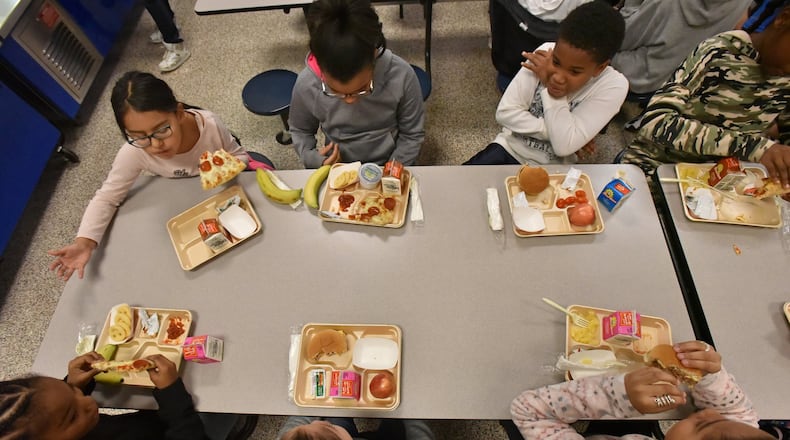Anyone who’s visited a school cafeteria has probably noticed that almost as much food goes into the trash as into the children’s stomachs.
Gwinnett County schools hopes to change that, by finding out just how much food is wasted and getting kids to eat more of it, turning scraps into compost or getting the food to families who need it.
The U.S. Department of Agriculture says Americans waste enough food every day to fill a 90,000-seat football stadium and schools are a major contributor.
VIDEO: More Gwinnett news
Gwinnett County Public Schools has partnered with Gwinnett Clean & Beautiful to set up "Food Waste Warriors," using a $20,000 grant through the Keep America Beautiful/Lowe's Community Partners program.
“The Food Waste Warriors project empowers students to implement innovative strategies to reduce the volume of food waste in schools, while also providing fresh, nutritious food to families in community who are food insecure, and ultimately, reducing the environmental impacts of food waste,” said aid Schelly T. Marlatt, executive director of Gwinnett Clean & Beautiful, which received a grant for the second consecutive year.
Food-waste audits are conducted at 15 Gwinnett schools during lunchtime. The audits help identify steps to reduce the waste, then the schools can apply to Gwinnett Clean & Beautiful for funding to carry out their ideas.
The USDA has recommended best practices:
- Extend lunch from 20 to 30 minutes: Travel to and from the cafeteria, socializing and waiting in line may take up too much eating time.
- Offer cut-up or sectioned fruits such as apples and oranges. Some whole fruits are challenging to eat and peel.
- Establish a school garden. Students are more willing to eat what they have grown.
- Give dishes more appealing names.
- Offer a "share table" where students may give or take leftover whole or packaged items.
- Allow some items to be removed from the cafeteria to be consumed later.
“We also record weights of recyclables (milk cartons, water bottles, etc.) as well as unopened/uneaten foods hoping that a share table can be created (if not already established) where students who do not have a snack or are still hungry, can take items,” said Marlatt.
The first phase is slated to wrap up by the end of this month, but improvement-strategy implementation will continue through the school year and in the years to follow, she added.
“From our perspective the goals would be to increase student consumption and reduce student waste, to educate our students on what food items define a school meal, and to clearly define items that must be taken while balancing that with encouraging them to take only what they will consume,” said Ken Yant, the school district’s nutrition director.
The USDA has encouraged schools to find ways to make sure students aren't just buying meals, but actually eating them. In 2017 it reimbursed schools $3.07 for each free lunch and $2.67 for a reduced-price lunch. With 21.5 million free and reduced-price lunch eaters nationally, the potential cost if everyone wasted a 75-cent orange or apple would be more than $16 million.
“Our school district serves 200,000 students, each producing 2-plus pounds of compostable waste each day,” said Marlatt. “By diverting up to 40 percent of food waste through the installation of composting systems and ‘share tables,’ this project will help reduce our community’s growing concern with food waste, help the school district save disposal costs, and conserve landfill space.”
The compost produced will be used in the school’s gardens to grow more fresh vegetables, which can be donated to food cooperative ministries to feed families who lack access to nutritious, fresh foods. Right now Gwinnett public schools donate over 500 pounds of vegetables and herbs a month.
Gwinnett County has more than 960,000 residents, according to county officials, and is on target to exceed one million by the next U.S. Census. With the growing population it is important to focus on the limited natural resources for growing enough food to meet demands, while minimizing waste, said Marlatt.
Yant said he’s looking forward to seeing the data and developing a strategy for the entire school district.
“I would anticipate recommendations from the final report,” he said. “Regardless, we will use the data to evaluate our menu items and make deliberate and appropriate decisions that will still allow us to maintain our program without compromising our food quality and menu selections and work towards the stated goals.”
Cutting down school food waste is an attainable goal, said Marlatt.
“The ultimate community benefit is to build an awareness of the global problem of food waste and the burden being placed on our environment and our community,” she said. “Helping to mold the next generation of educated, involved environmental stewards is a win-win for all of us.”
Why it matters
Student food waste in public schools costs taxpayers as much as $16 million a year. Changing practices in schools has the double benefit of reducing the amount of wasted food while also educating students about the need to reduce food waste and the ways this can be done. Catching students while they are young can help lead to the type of societal change needed to cut back on food waste.
About the Author
Keep Reading
The Latest
Featured




